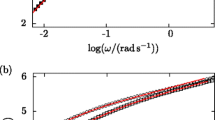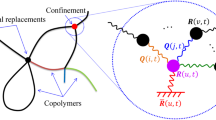Abstract
We present a critical assessment of the range of validity of the empirical Cox-Merz rule for a wide range of model entangled polymer samples with a well-defined molecular structure, from linear monodisperse and polydisperse polymers, to branched model polymers (i.e. stars, H-polymers, and combs) and blends of linear polymers of the same chemistry. We focus on melts and concentrated solutions. Overall, we find that the simple empirical rule is obeyed rather well for the investigated cases. As often reported in the literature, relatively small systematic failures occur with the steady viscosity being below the complex one at high rates for most polymers, with linear polydisperse polymers (with a polydispersity index of about 2) being a notable exception. For the latter polymers, the rule is obeyed identically within experimental error. More unusual failures, with the steady shear viscosity being higher than the complex viscosity, are found for branched polymers with more than one branch point. More specifically, these unusual failures are observed at very high branching levels, when the backbone of the polymer is being stretched at low rates due to the motion of the branch points. The extra stress coming for the stretch renders the steady viscosity higher than the complex one. Due to the well-characterized nature of the combs, we can state that failures of the latter type are only apparent when the branches comprise more than 70 % of the molecular structure of the comb. This estimation could serve as a rough guideline in applications, although it is only a necessary and not sufficient condition for these failures to occur.







Similar content being viewed by others
References
Al-Hadithi TSR, Barnes HA, Walters K (1992) The relationship between the linear (oscillatory) and nonlinear (steady-state) flow properties of a series of polymer and colloidal systems. Colloid Polym Sci 270:40
Andreev M, Feng H, Yang L, Schieber JD (2014) Universality and speedup in equilibrium and nonlinear rheology predictions of the fixed slip-link model. J Rheol 58:723–736
Archer LA, Juliani A (2004) Linear and nonlinear viscoelasticity of entangled multiarm (Pom-Pom) polymer liquids. Macromolecules 37:1076–1088
Auhl D, Ramirez J, Likhtman AE, Chambon P, Fernyhough C (2008) Linear and nonlinear shear flow behavior of monodisperse polyisoprene melts with a large range of molecular weights. J Rheol 52:801–835
Barnes HA, Hutton JF, Walters K (1989) An introduction to rheology. Elsevier
Booij HC, Leblans P, Palmen J, Tiemersma-Thoone G (1983) Nonlinear viscoelasticity and the Cox-Merz relations for polymeric fluids. J Polym Sci, Polym Phys Ed 21:1703–1711
Chang T (2005) Polymer characterization by interaction chromatography. J Polym Sci B Polym Phys 43:1591–1607
Cox WP, Merz EH (1958) Correlation of dynamic and steady flow viscosities. J Polym Sci 28:619
Das C, Inkson NJ, Read DJ, Kelmanson MA, McLeish TCB (2006) Computational linear rheology of general branch-on-branch polymers. J Rheol 50:207–234
Das C, Read DJ, Auhl D, Kapnistos M, den Doelder J, Vittorias I, McLeish TCB (2014) Numerical prediction of nonlinear rheology of branched polymer melts. J Rheol 58:737–758
de Gennes PG (1971) Reptation of a polymer chain in the presence of fixed obstacles. J Chem Phys 55:572–579
Dealy JM, Larson RG (2006) Structure and rheology of molten polymers. Publishers, Hanser
Doi M (1983) Explanation for the 3.4-power law for viscosity of polymeric liquids on the basis of the tube model. J Polym Sci, Polym Phys Ed 21:667–684
Doi M, Edwards SF (1978a) Dynamics of concentrated polymer systems. Part 1—brownian motion in the equilibrium state. J Chem Soc, Faraday Trans 2(74):1789–1801
Doi M, Edwards SF (1978b) Dynamics of concentrated polymer systems. Part 2—molecular motion under flow 1802-1817. J Chem Soc, Faraday Trans 2:74
Doi M, Edwards SF (1978c) Dynamics of concentrated polymer systems. Part 3—the constitutive equation. J Chem Soc, Faraday Trans 2(74):1818–1832
Doi M, Edwards SF (1979) Dynamics of concentrated polymer systems. Part 4—rheological properties. J Chem Soc, Faraday Trans 2(75):38–54
Doi M, Edwards SF (1986) The theory of polymer dynamics. Clarendon Press
Doi M, Takimoto J (2003) Molecular modelling of entanglement. Phil Trans R Soc Lond A 361:641–652
Ferri D, Lomellini P (1999) Melt rheology of randomly branched polystyrenes. J Rheol 43:1355–1372
Ferry JD (1980) Viscoelastic properties of polymers, 3rd edn. Wiley-Interscience, NY
Graessley WW (2008) Polymeric liquids & networks: dynamics and rheology. Taylor & Francis group LLC, NY
Graham RS, Alexei E, Likhtman AE, Tom CB, McLeish TCB, Milner ST (2003) Microscopic theory of linear, entangled polymer chains under rapid deformation including chain stretch and convective constraint release. J Rheol 47:1171–1200
Hajichristidis N, Iatrou H, Pispas S, Pitsikalis M (2000) Anionic polymerization: high vacuum techniques. J Polym Sci A Polym Chem 38:3211–3234
Hua CC (2000) Investigations on several empirical rules for entangled polymers based on a self-consistent full-chain reptation theory. J Chem Phys 112:8176–8186
Hua CC, Schieber JD (1998) Segment connectivity, chain-length breathing, segmental stretch, and constraint release in reptation models. I. Theory an single-step strain predictions. J Chem Phys 109:10018
Huang Q, Alvarez NJ, Matsumiya Y, Rasmussen HK, Watanabe H, Hassager O (2013) Extensional rheology of entangled polystyrene solutions suggests importance of nematic interactions. ACS Macro Lett 2:741–744
Ianniruberto G, Marrucci G (1996) On the compatibility of the Cox-Merz rule with the model of Doi and Edwards. J Non-Newtonian Fluid Mech 65:241–246
Ianniruberto G, Marrucci G (2002) A multi-mode CCR model for entangled polymers with chain stretch. J Non-Newtonian Fluid Mech 102:383–395
Ianniruberto G, Marrucci G (2014) Convective constraint release (CCR) revisited. J Rheol 58:89–102
Kapnistos M, Vlassopoulos D, Roovers J, Leal LG (2005) Linear rheology of architecturally complex macromolecules: comb polymers with linear backbones. Macromolecules 38:7852–7862
Kapnistos M, Lang M, Vlassopoulos D, Pyckhout-Hintzen W, Richter D, Cho D, Chang T, Rubinstein M (2008) Unexpected power-law stress relaxation of entangled ring polymers. Nat Mat 7:997–1002
Kapnistos M, Kirkwood KM, Ramirez J, Vlassopoulos D, Leal LG (2009) Nonlinear rheology of model comb polymers. J Rheol 53:1133–1153
Kirkwood KM, Leal LG, Vlassopoulos D, Driva P, Hadjichristidis N (2009) Stress relaxation of comb polymers with short branches. Macromolecules 42:9592–9608
Larson RG (1985) Constitutive relationships for polymeric materials with power-law distributions of relaxation times. Rheol Acta 24:327–334
Larson RG (2001) Combinatorial rheology of branched polymer melts. Macromolecules 34:4556–4571
Lee JH, Driva P, Hadjichristidis N, Wright PJ, Rucker SP, Lohse DJ (2009) Damping behavior of entangled comb polymers: experiment. Macromolecules 42:1392–1399
Lentzakis H, Vlassopoulos D, Read DJ, Lee H, Chang T, Driva P, Hadjichristidis N (2013) Uniaxial extensional rheology of well-characterized comb polymers. J Rheol 57:605–625
Liu G, Cheng S, Lee H, Ma H, Xu H, Chang T, Quirk RP, Wang S-Q (2013) Strain hardening in startup shear of long-chain branched polymer solutions. Phys Rev Lett 111:068302
Macosko CW (1994) Rheology: Principles, measurements and applications. Wiley-VCH
Marrucci G (1985) Relaxation by reptation and tube enlargement: a model for polydisperse polymers. J Polym Sci B Polym Phys Ed 23:159–177
Marrucci G (1996) Dynamics of entanglements: a nonlinear model consistent with the Cox-Merz rule. J Non-Newtonian Fluid Mech 62:279
Masubuchi Y, Matsumiya Y, Watanabe H, Marrucci G, Ianniruberto G (2014) Primitive chain network simulations for Pom-Pom polymers in uniaxial elongational flows. Macromolecules. doi:10.1021/ma500357g
McLeish TCB (1988) Hierarchical-relaxation in tube models of branched polymers. Europhys Lett 6:511–516
McLeish TCB (2002) Tube theory of entangled polymer dynamics. Adv Phys 51:1379–1527
McLeish TCB, Larson RG (1998) Molecular constitutive equations for a class of branched polymers: the pom-pom polymer. J Rheol 42:81
Mead DW (2007) Development of the “binary interaction” theory for entangled polydisperse linear polymers. Rheol Acta 46:369–395
Mead DW (2012) Analytic derivation of the Cox–Merz rule using the MLD “toy” model for polydisperse linear polymers. Rheol Acta 50:837–866, 2011
Mead DW, Larson RG, Doi M, Mead DW, Larson RG, Doi M (1998) A molecular theory for fast flows of entangled polymers. Macromolecules 31:7895–7914
Meissner J, Garbella RW, Hostettler J (1989) Measuring normal stress differences in polymer melt shear-flow. J Rheol 33:843
Menezes EV, Graessley WW (1980) Study of the nonlinear response of a polymer solution to various uniaxial shear flow histories. Rheol Acta 19:38–50
Menezes EV, Graessley WW (1982) Nonlinear rheological behavior of polymer systems for several shear-flow histories. J Polym Sci, Polym Phys Ed 20:1817–1833
Osaki K, Inoue T, Isomura T (2000) Stress overshoot of polymer solutions at high rates of shear; polystyrene with bimodal molecular weight distribution. J Polym Sci, Polym Phys Ed 38:2043–2050
Pasquino R, Zhang B, Sigel R, Yu H, Öttiger M, Bertran O, Aleman C, Schlüter AD, Vlassopoulos D (2012) Linear viscoelastic response of dendronized polymers. Macromolecules 45:8813–8823
Pasquino R, Vasilakopoulos TC, Jeong YC, Lee H, Rogers S, Sakellariou G, Allgaier J, Takano A, Bras AR, Chang T, Goossen S, Pyckhout-Hintzen W, Wischnewski A, Hadjichristidis N, Richter D, Rubinstein M, Vlassopoulos D (2013) Viscosity of ring polymer melts. ACS Macro Lett 2:874–878
Pattamaprom C, Larson RG (2001) Constraint release effects in monodisperse and bidisperse polystyrenes in fast transient shearing flows. Macromolecules 34:5229–5237
Pearson D, Herbolzheimer E, Grizzuti N, Marrucci G (1991) Transient behavior of entangled polymers at high shear rates. J Polym Sci B 29:1589–1597
Read DJ, Auhl D, Das C, den Doelder J, Kapnistos M, Vittorias I, McLeish TCB (2011) Linking models of polymerization and dynamics to predict branched polymer structure and flow. Science 333:1871–1874
Roovers J (1979) Synthesis and dilute solution characterization of comb polystyrenes. Polymer 20:843–849
Roovers J (1984) Melt rheology of H-shaped polystyrenes. Macromolecules 17:1196
Roovers J, Graessley WW (1981) Melt rheology of some model comb polystyrenes. Macromolecules 14:766–773
Roovers J, Toporowski PM (1981) Preparation and characterization of H-shaped polystyrenes. Macromolecules 14:1174
Schulken RM, Cox RH, Minnick LA (1980) Dynamic and steady state rheological measurements on polymer melts. J Appl Polym Sci 25:1341–1353
Schweizer T (2002) Measurement of the first and second normal stress differences in a polystyrene melt with a cone and partitioned plate tool. Rheol Acta 41:337
Schweizer T (2003) Comparing cone partitioned plate and cone standard plate shear rheometry of a polystyrene melt. J Rheol 47:1071
Schweizer T, van Meerveld J, Öttinger HC (2004) Nonlinear shear rheology of polystyrene melt with narrow molecular weight distribution—experiment and theory. J Rheol 48:1345
Snijkers F, Vlassopoulos D (2011) Cone-partitioned-plate geometry for the ARES rheometer with temperature control. J Rheol 55:1167
Snijkers F, Vlassopoulos D, Lee H, Yang J, Chang T, Driva P, Hadjichristidis N (2013a) Start-up and relaxation of well-characterized comb polymers in simple shear. J Rheol 57:1079–1100
Snijkers F, Vlassopoulos D, Ianniruberto G, Marrucci G, Lee H, Yang J, Chang T (2013b) Double stress overshoot in start-Up of simple shear flow of entangled comb polymers. ACS Macro Lett 2:601–604
Snijkers F, Ratkanthwar K, Vlassopoulos D, Hadjichristidis N (2013c) Viscoelasticity, nonlinear shear start-up, and relaxation of entangled star polymers. Macromolecules 46:5702–5713
Tezel AK, Oberhauser JP, Graham RS, Jagannathan K, McLeish TCB, Leal LG (2009) The nonlinear response of entangled star polymers to startup of shear flow. J Rheol 53:1193–1214
van Ruymbeke E, Bailly C, Keunings R, Vlassopoulos D (2006) A general methodology to predict the linear rheology of branched polymers. Macromolecules 39:6248–6259
van Ruymbeke E, Masubuchi Y, Watanabe H (2012) Effective value of the dynamic dilution exponent in bidisperse linear polymers: from 1 to 4/3. Macromolecules 45:2085–2098
Wang S-Q, Ravindranath S, Boukany PE (2011) Homogeneous shear, wall slip, and shear banding of entangled polymeric liquids in simple-shear rheometry: a roadmap of nonlinear rheology. Macromolecules 44:183–190
Wen YH, Lin HC, Li CH, Hua CC (2004) An experimental appraisal of the Cox-Merz rule and Laun’s rule based on bidisperse entangled polystyrene solutions. Polymer 45:8551–8559
Winter HH (2009) Three views of viscoelasticity for Cox-Merz materials. Rheol Acta 48:241–243
Yaoita T, Isaki T, Masubuchi Y, Watanabe H, Ianniruberto G, Marrucci G (2012) Primitive chain network simulation of elongational flows of entangled linear chains: stretch/orientation-induced reduction of monomeric friction. Macromolecules 45:2773–2782
Yasuda K, Armstrong RC, Cohen RE (1981) Shear flow properties of concentrated solutions of linear and star branched polystyrenes. Rheol Acta 20:163–178
Acknowledgments
We thank J. Roovers, K. Ratkanthwar, and N. Hadjichristidis for generously providing the model branched polymers used in this work. We also thank S. Coppola for generously providing polydisperse linear PS samples. We further thank G. Marrucci, G. Ianniruberto, and R. Pasquino for stimulating discussions. Support from the EU (FP7 ITN DYNACOP, grant 214627 and from the FP7 infrastructure ESMI, GA-262348) is gratefully acknowledged.
Author information
Authors and Affiliations
Corresponding author
Additional information
Special issue devoted to novel trends in rheology
Rights and permissions
About this article
Cite this article
Snijkers, F., Vlassopoulos, D. Appraisal of the Cox-Merz rule for well-characterized entangled linear and branched polymers. Rheol Acta 53, 935–946 (2014). https://doi.org/10.1007/s00397-014-0799-6
Received:
Revised:
Accepted:
Published:
Issue Date:
DOI: https://doi.org/10.1007/s00397-014-0799-6




